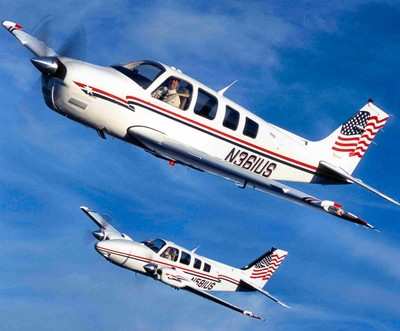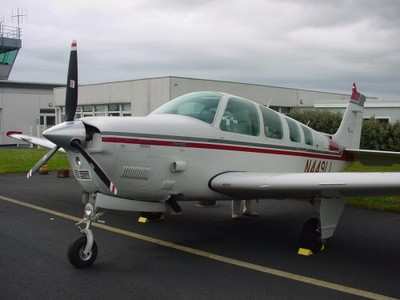African Instructor Learns The Hard Way: Keep Your Head In The
Cockpit
By Gary Wiblin, Editor, Aviation Safety Forum
It was a beautiful, sunny, Sunday morning as I lifted off runway
26 in Port Elizabeth, stowed the wheels and turned out right for
Seretse Khama. I was flying a magnificent example of a Bonanza 36
and everything was purring along just as it should. I was on my way
to fetch the owner in Maun, Botswana. I had dropped he and his
family off there a week previously and it was now time for them to
head for home.
After re-fuelling and completing the necessary formalities for
entering the country of Botswana, I again took off into a clear
blue sky. I remember sitting at FL 090, with the auto-pilot taking
its cue from the GPS, and thinking that this was indeed a darn fine
way to earn a living. After crossing the Kalahari desert, I would
soon be landing in Maun where I would be meeting two of my
ex-students who were now working out of Maun. Our plans for the
afternoon involved the consumption of large quantities of beer and
much chewing of the fat. I was looking forward to this.

A couple of hours later, I started descending into Maun. I was
soon cleared to land on runway 08 and I lined up for what was to be
a perfect touch-down. The possibility that my ex-students were not
only waiting for me, but were possibly actually watching my
approach played on my mind, and I resolved to make the landing a
flawless one.
The main wheels gently kissed the runway and before the
nose-wheel touched, I shot out my right hand to retract the flaps
-- and instead, accidentally did the slickest gear retraction I
have ever done. As I saw the prop curling back I realized what I
had just done and immediately slammed the gear lever back into the
down position. Bearing in mind that the Bonanza has about a three
second retraction cycle, there was no way that the nose-wheel was
going to come out again. The main wheels, however, made a gallant
effort to do so. The right main wheel actually locked back into the
down position, but the left one tried valiantly for a while before
finally also giving up the battle, and the aircraft screeched to a
grinding halt, coming to rest on its nose and the left-hand
wingtip.
I remember switching off the mags, master and fuel. I then
unplugged my headset and rolled up the chord. As I stepped off the
precariously teetering right-hand wing, people and vehicles began
appearing all around me. This was not the arrival I had
envisaged.
The following few hours are now just a blur. I can just remember
stamping up and down cursing myself for my stupidity and wishing
that I could turn back the clock. The Botswana accident
investigation official was on the scene immediately and within
thirty minutes we were in his office and he spent the next hour or
so scrutinizing all the paper-work. This is where I appreciated the
need to have all the T's crossed and the I's dotted. After what
seemed an eternity, he seemed satisfied enough to release me. The
hardest thing that I have ever had to do was to tell the owner that
I had just smeared his pride and joy down the runway.

Why did this accident happen? I spent many days, weeks, and
months mulling over what could have caused it. I never retract the
flaps shortly after touch-down, but I have been known to do so
while still rolling. Even then though, I would always say
"flap/identify/retract". Even though the Bonanza that I was flying
had the flap and undercarriage controls reversed, ie. gear left and
flap right, I do not think that this was the reason either. I never
reached for the flap lever, I reached for the undercarriage. It was
a spontaneous reaction. I tried to think of anything else that
might have contributed to my momentary madness. Before I left that
morning I initially could not find the aircraft, it had been moved
to a different hangar. After much searching I finally located my
steed. The customs official had also not arrived and after many
phone calls we finally touched sides. My son was extremely ill and
had been for some time. Did all of these factors reduce my mental
capability on that day or could this just be seen as excuse
finding.
I finally decided that the main cause of this accident was
procedural. I have often flown with pilots in the twenty or thirty
thousand hour bracket and when flying with these pilots, if you
reach for anything after touch-down, they become hostile and even
aggressive. I always used to consider this to be over-kill or even
paranoia. We need to take our cues from these people. If they have
managed to reach twenty or thirty thousand hours and are still
around to tell the tale, they must have learned a few things along
the way. At the time of this accident I had seven thousand hours of
incident-free flying under my belt. I had begun to think that
mistakes were things that other people made.
The positive spin-off is that I am an active Flying Instructor
and have taken this experience into the training environment. If I
now see flailing hands after touch-down I get extremely tense. I
now insist that the right hand remains firmly on the throttle/s
until the aircraft has been pulled clear of the runway and stopped.
Even then, when retracting the flaps, be careful that you have the
correct lever. Do not expect the squat-switch to prevent the wheels
from retracting. These switches have been known to fail. The
negative aspect of all this is that there is now a disillusioned
and disappointed aircraft owner. There is also an insurance company
that likes me not one jot.
We'll never really know, but maybe I have prevented a few future
accidents by writing this article. I hope so. I still sometimes
wake up at night with screeching, tearing, very expensive sounding
noises assailing my ears, but at last I can now say it, "I learned
about flying from that".
(Gary Wiblin is editor of Aviation Safety Forum. He's an
instructor with more than 9000 hours of total time. Based in Port
Elizabeth, South Africa, and will soon publish a new aviation
magazine called Flight Training & Aviation Safety.)
 ANN's Daily Aero-Linx (04.15.24)
ANN's Daily Aero-Linx (04.15.24) Classic Aero-TV: 'No Other Options' -- The Israeli Air Force's Danny Shapira
Classic Aero-TV: 'No Other Options' -- The Israeli Air Force's Danny Shapira Aero-News: Quote of the Day (04.15.24)
Aero-News: Quote of the Day (04.15.24) Airborne 04.16.24: RV Update, Affordable Flying Expo, Diamond Lil
Airborne 04.16.24: RV Update, Affordable Flying Expo, Diamond Lil ANN's Daily Aero-Term (04.16.24): Chart Supplement US
ANN's Daily Aero-Term (04.16.24): Chart Supplement US




